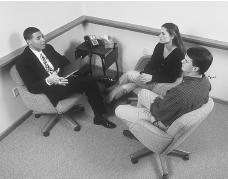Couples therapy

Definition
Couples therapy is a form of psychological therapy used to treat relationship distress for both individuals and couples.
Purpose
The purpose of couples therapy is to restore a better level of functioning in couples who experience relationship distress. The reasons for distress can include poor communication skills, incompatibility, or a broad spectrum of psychological disorders that include domestic violence, alcoholism, depression, anxiety, and schizophrenia . The focus of couples therapy is to identify the presence of dissatisfaction and distress in the relationship, and to devise and implement a treatment plan with objectives designed to improve or alleviate the presenting symptoms and restore the relationship to a better and healthier level of functioning. Couples therapy can assist persons who are having complaints of intimacy, sexual, and communication difficulties.
Precautions
Couples who seek treatment should consult for services from a mental health practitioner who specializes in this area.
Patients should be advised that honesty, providing all necessary information, cooperation, keeping appointments on time, and a sincere desire for change and improvement are all imperative to increase the chance of successful outcome. Additionally, a willingness to work "towards" and "with" the process of treatment is essential.
Description
Couples therapy sessions differ according to the chosen model, or philosophy behind the therapy. There are several models for treating couples with relationship difficulties. These commonly utilized strategies include psychoanalytic couples therapy, object relations couple therapy, ego analytical couples therapy, behavioral couples therapy, integrative behavioral couples therapy, and cognitive behavioral couples therapy.
Psychoanalytical couples therapy
Psychoanalytic therapy attempts to uncover unresolved childhood conflicts with parental figures and how these behaviors are part of the current relationship problems. The psychoanalytic approach tends to develop an understanding of interpersonal interactions (at present) in connection with early development. The success in development of early stages dictates the future behavior of interpersonal relationships. The essential core of this model deals with the process of separation and individuation (becoming a separate, distinct self) from mother-child interactions during childhood. A critical part of this model is introjection. The process of introjection includes introjects (infant processing versions) of the love object (mother). The developmental process of introjection forms the basis an unconscious representation of others (objects) and is vital for development of a separate and defined sense of self. The psychoanalytic approach analyzes marital relations and mate selection as originating from parent-child relationship during developmental stages of the child.
Object relations couple therapy
The object relations model creates an environment of neutrality and impartiality to understand the distortions and intrapsychic (internalized) conflicts that each partner contributes to the relationship in the form of dysfunctional behaviors. This model proposes that there is a complementary personality fit between couples that is unconscious and fulfills certain needs. This model supports the thought that a "mothering figure" is the central motivation for selection and attachment of a mate. Choosing a "mothering" figure induces further repression (non-development) of portions of personality that were not well-developed (referred to as "lost parts"). This repression causes relationship difficulties.
Ego analytic couples therapy
Ego analytical approaches utilize methods to foster the ability to communicate important feelings in the couple's relationship. This model proposes that dysfunction originates from the patient's incapabilities to recognize intolerance and invalidation of sensitivities and problems in a relationship. According to this model, there are two major categories of problems. The first category of problems relates to dysfunction brought into the relationship from early childhood trauma and experiences. The second

Behavioral marital therapy
Behavioral marital therapists tend to improve relationships between a couple by increasing positive exchanges and decreasing the frequency of negative and punishing interactions. This model focuses on the influence that environment has in creating and maintaining relationship behavior. Behavior exchange between partners is flowing continuously and prior histories can affect relationship interactions. Behavior therapy in general is based on the idea that when certain behaviors are rewarded, they are reinforced. The amount of rewards (positive reinforcers) received in relation to the amount of aversive behavior is linked to an individual's sense of relationship dissatisfaction.
Integrative behavioral couples therapy
Integrative behaviorists help couples by improving behavior exchange, communication, and the couples' abilities for problem-solving skills. The integrative behavioral therapy approach examines functioning of the couple and is more flexible and individualized to specific problems in the relationship than behavior marital therapy. This approach examines problems and interactions that are repetitious (acts that are repeatedly done causing relationship problems).
Cognitive behavior marital therapy
The cognitive approach therapist educates and increases awareness concerning perceptions, assumptions, attributions or standards of interaction between the couple. The central theme for understanding marital discourse using cognitive behavioral therapy is based on the behavioral marital therapy model. A couple's emotional and behavioral dysfunction are related to inappropriate information processing (possibly "jumping to conclusions," for example) and negative cognitive appraisals. This models attempts to discover the negative types of thinking that drive negative behaviors that cause relationship distress.
Emotionally focused therapy
Emotionally focused therapy assists patients to acknowledge, assess, and express emotions that are related to distress. This model views emotion and cognition (thinking) as interdependent and that emotion is a primary "driver" of interpersonal expression. The primary theme of emotionally focused therapy is that couple distress stems from unexpressed and unacknowledged emotional needs. The dysfunction arises from negative interactions from emotions that have been withheld from disclosure from each partner.
Structural strategic marital therapy
Structural strategic therapists will challenge existing negative perceptions and present alternative possibilities and behaviors. These alternate behaviors encourage positive perceptions by role-playing. This model views relationship progression in developmental stages. According to this model, the couple's distress reflects difficulties in coping mechanisms related to life changes— either environmental or personal change. Despite relationship dissatisfaction, the couple will tend to resist change, maintaining status quo, and attempting baseline functioning to keep the system going.
Preparation
Couples should be informed that cooperation is vital for the process. Couples should have a desire to modify and/or change dysfunctional behaviors. Honesty and emotional openness is a necessary component for treatment. Results cannot be guaranteed. The psychotherapist would typically provide an extensive assessment process during the initial appointment. This couples assessment process usually includes in-depth information gathering concerning the presenting problem, and assessment of occupations, schooling, employment, childhood development, parental history, substance abuse, religion, relational, medical, legal, and past psychological history, in the form an interview. The psychotherapist can then devise the best course of treatment planning. Further psychological tests and measurements may be indicated initially or as the need arises during the treatment process.
Aftercare
Treatment usually takes several months or longer. Once the couple has developed adequate skills and has displayed an improved level of functioning that is satisfactory to both, then treatment can be terminated. An awareness of relapse prevention behaviors and relapsing behaviors is important. (Relapsing behaviors refer to the return to the behaviors that the couple is trying to change or eliminate.) Patients are encouraged to return to treatment if relapse symptoms appear. Follow-up visits and long-term psychological therapy can be arranged between parties if this is mutually decided as necessary and beneficial.
Risks
The major risk of couples therapy is lack of improvement or return to dysfunctional behaviors. These tend not to occur unless there is a breakdown in skills learned and developed during treatment, or a person is resistant to long-term change.
Normal results
A normal progression of couples therapy is relief from symptomatic behaviors that cause marital discourse, distress, and difficulties. The couple is restored to healthier interactions and behaviors are adjusted to produce a happier balance of mutually appropriate interactions. Patients who are sincere and reasonable with a willingness to change tend to produce better outcomes. Patients usually develop skills and increased awareness that promotes healthier relationship interactions.
Abnormal results
There are no known abnormal results from couples therapy. At worst, patients do not get better because they cannot break away from self-induced, self-defeating behaviors that precipitate marital dysfunction and distress. The problems are not worsened if treatment is provided by a trained mental health practitioner in this specialty.
Resources
BOOKS
Noble, John, and others. Textbbok of Primary Care Medicine. 3rd Edition. Mosby, Inc. 2001: 58-62.
Tasman, Allan, and others. Psychiatry. 1st Edition. Philadelphia: W. B. Saunders Company, 1997: 1452-1461.
PERIODICALS
Hampson, R. B, C. C. Prince, W. R. Beavers. "Marital therapy: qualities of couples who fare better or worse in treatment." Journal of Marital and Family Therapy 25, no. 4 (October 1999): 411-24.
ORGANIZATIONS
The American Association for Marriage and Family Therapy. 1133 15th Street NW, Suite 30, Washington, DC 20005. Phone: (202) 452-0109. Fax: (202) 223-2329. Web site: <http:/www.aamft.org> .
Laith Farid Gulli, M.D. Kathleen Berrisford, M.S.W.,CSW, CAC
Comment about this article, ask questions, or add new information about this topic: